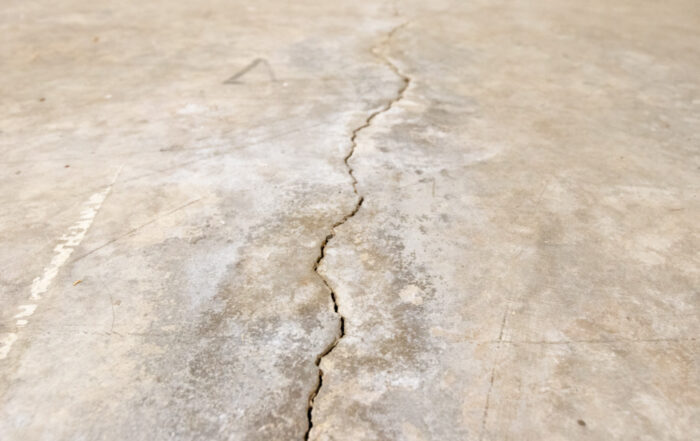Slab Foundation vs. Pier and Beam: Which is More Common in Texas?

Did you know you don’t need to have a full basement to have a proper foundation for your home? In fact, in a lot of warmer climates like Florida, Georgia, and Texas, you might find homes without a basement at all.
This is because the frost line is so much shallower in the ground that a full basement isn’t required to insulate pipes, laundry, etc. This brings us to the most viable options for foundations in Texas:
- Pier and beam foundations
- Concrete slab foundations
While slab foundations are one of the most commonly used types of foundations, pier and beam foundations are also very widely used across Texas. Ease of repairs, installation, and longevity are all things people might look at when determining which of the two will work best.
So when it comes to pier and beam vs slab foundations— weighing the pros and cons can help you determine which is the superior option for your home. This guide will help you get there.
Pier and Beam vs Slab Foundation: What’s The Difference?
Pier and beam vs. slab foundations are quite different. Pier and beam foundations were primarily used pre-concrete, while slab foundations began to grow in popularity once concrete mixes and techniques improved throughout the years. Slab foundations have nearly replaced pier and beam as the most common type of structural foundations.
What Are Pier and Beam Foundations?
Pier and beam foundations are exactly what it sounds like— the structure is propped up on top of deeply grounded piers and beams. You might call it a house on stilts, in a sense. Many structures in areas with tides or that are prone to flooding can benefit from having such a foundation.
Other benefits of pier and beam foundations include:
- Flood protection
- Easy access to pipes, wires, crawlspace, repairs
- No/low excavation costs
- More mobile— can move and relocate a house more easily
- More flexible for uneven ground sites
Pier and beam foundations are primarily used in residential construction, but can occasionally be seen in light commercial buildings. They’re not recommended for taller structures as the pier might not be able to support the weight and height without additional reinforcement.
What Are Slab Foundations?
Slab foundations are made by pouring concrete over a prepared gravel base. Once the concrete has cured, the slab becomes one monolithic piece that the home is then built on top of. The gravel base helps with drainage and prevents water from seeping up through the concrete and into the home.
Benefits of slab foundations include:
- Fast installation with fewer steps
- Concrete cures quickly
- Protects against pests
- More protection against flooding, gas leaks, or other elemental disasters
- Can hold more weight
Slab foundations are most commonly used in residential construction for single or multi-family homes. They may also be used in commercial construction, but most likely those will have full concrete basements with walls as a foundation— just for the sheer weight of the structure.
Pier and Beam Foundation Pros and Cons
Now that we know a little more about pier and beam vs slab foundations, let’s expand on the benefits we’ve listed and look at the pros and cons of pier and beam foundations:
Pier and Beam Foundation Pros
Flood Protection: One of the main pier and beam foundation advantages is that they’re raised off the ground, which offers protection against flooding.
Easily Accessible: The crawl space underneath a pier and beam foundation allows for easily accessible repairs to your foundation, plumbing, or electrical. This can save a ton of money on labor costs for repairs.
Cost-Effective: Because pier and beam foundations don’t require as much concrete, they tend to be more cost-effective than slab foundations.
More Mobility: Have you ever wanted to pick up your house and move it? Well, pier and beam foundations make that possible. If you own a pier and beam home, you can have it moved without too much difficulty (although we don’t recommend it).
Flexible for Uneven Ground: Slab foundations must be level to properly balance a home, but pier and beam foundations can be cut to varying lengths to counteract an uneven surface such as a hill or mound. This can save a ton of time and energy on excavation and leveling the area before installation.
More Flexibility: In general, pier and beam foundations offer more flexibility than slab foundations. For example, if you want to add a porch or deck onto your pier and beam home, it’s much easier to do so than if your home was built on a slab foundation.
More Air Flow: Because pier and beam foundations are raised off the ground, they offer better airflow underneath the home. This can help with cooling in the summer and prevent moisture buildup which could lead to mold or mildew— which in turn, can lower energy costs.
Pier and Beam Foundation Cons
Sagging Issues: With nothing solid like concrete beneath a structure, the floors are at risk of sagging, bouncing, and creaking.
Heavier Structures: Because pier and beam foundations don’t have the support of a solid concrete slab, they can’t hold as much weight. So, if you’re planning on building a multi-story home or something particularly heavy, like a stone fireplace, a pier and beam may not be the best foundation.
Rotting Wood: Because pier and beam foundations are made of wood, they’re susceptible to rotting if they come into contact with too much moisture.
Expensive Repairs: Although pier and beam foundations offer easily accessible repairs, they can be expensive because of the amount of materials needed. For example, you may need to replace an entire pier if it’s rotted beyond repair.
Rain Accumulation: While the pier and beam structure might be beneficial for flooding, it can also be counterintuitive with moisture— trapping it underneath if there’s exponential amounts of rain.
Not Ideal for Some Climates: If you live in an area with extreme cold or heat, pier and beam foundations may not be the best option. The expansion and contraction of pier and beam materials in these climates can cause cracking and other damage to your foundation.
Concrete Slab Foundation Pros and Cons
Concrete slab foundations are quite different from a standard pier and beam foundation. They may even have similar pros and cons, but either way, weighing all the options is vital to choosing the top solution for your home or structure’s foundation.
Slab Foundation Pros
Simple Installation: Slab foundations are much simpler to install than pier and beam foundations. Because they don’t require as many materials or labor, they tend to be less expensive and time-consuming.
Low Maintenance: Once a slab foundation is installed, there’s not much you need to do in terms of maintenance. With pier and beam foundations, you need to regularly check for water damage, rot, and other issues.
Increased Resale Value: Because they’re considered the standard foundation type, slab foundations generally have a higher resale value than pier and beam foundations.
Pest Protection: Slab foundations offer better protection against pests than pier and beam foundations. Because they’re built on a solid foundation, there are fewer cracks and crevices for pests to enter.
Protection Against Water Infiltration: Slab foundations are less likely to experience water infiltration.
More Durable: In general, slab foundations are very durable and less likely to experience cracking, settling, and other issues.
Cost-Effective: Slab foundations are typically more cost-effective as they require less materials and labor, so they tend to be less expensive.
Slab Foundation Cons
Risk of Cracks: One of the biggest disadvantages of slab foundations is that they’re at a higher risk for cracks. This is due to the fact that they’re made of concrete, which is a porous material.
Lack of Flexibility: Slab foundations offer very little flexibility. If you want to make any changes to your home after it’s built, it can be difficult and expensive to do so.
Poor Drainage: Another disadvantage of slab foundations is that they offer poor drainage. If there’s a lot of rain or water infiltration, the water can pool around your foundation and cause cracking.
Harder to Access: Slab foundations can be harder to access for repairs. This is because they’re built on a solid foundation, so if there are any issues, you may need to dig up your entire foundation to fix them.
Expensive Repairs: Because slab foundations are made of concrete, they can be expensive to repair if they crack or settle.
Requires Insulation: Slab foundations require insulation to prevent heat loss. This can be an added expense that you may not have considered.
Work With the Best Foundation Experts in Texas
So, what’s the verdict? Both pier and beam and slab foundations have their pros and cons, so it’s important to weigh all of your options before deciding which one is right for you. If you’re not sure, it’s always a good idea to consult with a professional foundation contractor. They can help you assess your needs and make the best decision for your home.



